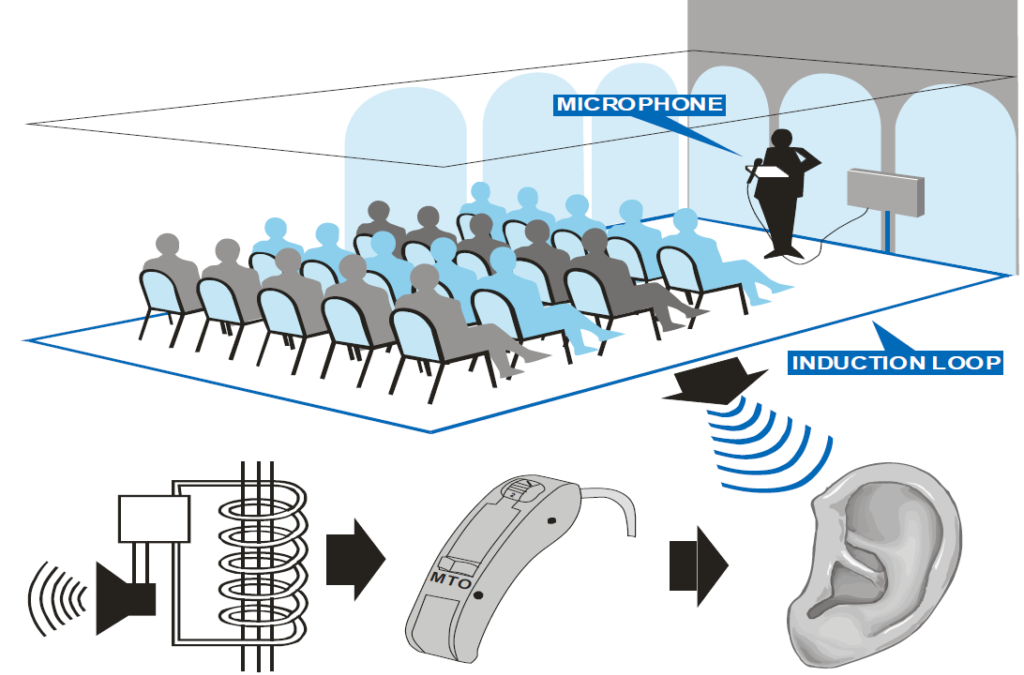I. Introduction
A. Explanation of Hearing Loops
Hearing loops are assistive listening systems that use magnetic fields to transmit sound directly into hearing aids or cochlear implants. The system involves a loop of wire that surrounds a room or a designated area, which generates a magnetic field that transmits sound to a receiver within a hearing aid.
B. Importance of Hearing Loops
Hearing loops are essential for individuals with hearing loss, as they provide a direct and clear audio signal without the interference of background noise or reverberation. They are also essential for accessibility and inclusion in public spaces, enabling individuals with hearing loss to fully engage in activities and events.
II. What is a Hearing Loop?
A. Definition of Hearing Loop
A hearing loop is an assistive listening system that transmits sound directly into hearing aids or cochlear implants through a magnetic field generated by a loop of wire.
B. How it Works
A hearing loop works by using a loop of wire that generates a magnetic field, which is picked up by a receiver within a hearing aid or cochlear implant. The signal transmitted through the magnetic field is direct and clear, eliminating background noise and reverberation.
C. Types of Hearing Loops
There are two main types of hearing loops: room loops and portable loops. Room loops are permanently installed in a room or designated area, while portable loops can be moved from room to room or taken with the individual.
III. How Does a Hearing Loop Benefit Hearing Impaired People?
A. Improves Sound Quality
Hearing loops provide a direct and clear audio signal, improving the sound quality for individuals with hearing loss.
B. Reduces Background Noise
The direct audio signal transmitted through the hearing loop eliminates background noise, making it easier for individuals with hearing loss to hear and understand speech.
C. Increases Clarity of Speech
Hearing loops improve the clarity of speech by reducing the interference of background noise and reverberation.
D. Enhances Communication
Hearing loops enable individuals with hearing loss to fully engage in activities and events, promoting inclusion and accessibility.
IV. Different Settings Where Hearing Loops Can be Installed
A. Places of Worship
Hearing loops are commonly installed in places of worship to ensure that individuals with hearing loss can fully participate in religious services.
B. Conference Rooms and Meeting Spaces
Hearing loops are essential in conference rooms and meeting spaces to ensure that individuals with hearing loss can fully participate in discussions and meetings.
C. Performance Venues and Theaters
Hearing loops are installed in performance venues and theatres to ensure that individuals with hearing loss can enjoy live performances without missing any dialogue or lyrics.
D. Public Transportation and Airports
Hearing loops are increasingly being installed in public transportation and airports to ensure that individuals with hearing loss can receive important announcements and information.
V. How to Get a Hearing Loop Installed
A. Steps to Install a Hearing Loop
The steps involved in getting a hearing loop installed include a consultation with a hearing loop professional, a site survey, installation, and testing.
B. Cost of Installation
The cost of hearing loop installation varies depending on the size of the area to be covered and the type of hearing loop system selected.
VI. Future of Hearing Loops
A. Advancements in Technology
Advancements in technology may include improved wireless connectivity, increased compatibility with hearing aids and cochlear implants, and better sound quality.
B. Potential for Increased Adoption
As awareness of hearing loops grows, there is potential for increased adoption in various settings such as workplaces, schools, and public spaces. This can promote greater accessibility and inclusion for individuals with hearing loss.
C. Conclusion
Hearing loops are an essential assistive listening system for individuals with hearing loss. They provide a direct and clear audio signal, improving sound quality, reducing background noise, and increasing clarity of speech. They can be installed in various settings such as places of worship, conference rooms, theatres, and public transportation. Getting a hearing loop installed involves consultation with a professional, site survey, installation, and testing. The future of hearing loops may involve advancements in technology and increased adoption in various settings to promote accessibility and inclusion.
VII. Conclusion
A. Recap of Hearing Loop Basics
Hearing loops are assistive listening systems that transmit sound directly into hearing aids or cochlear implants through a magnetic field generated by a loop of wire. They provide a direct and clear audio signal, improving sound quality, reducing background noise, and increasing clarity of speech.
B. Final Thoughts
Hearing loops are crucial for accessibility and inclusion for individuals with hearing loss. As awareness of hearing loops grows, there is potential for increased adoption in various settings, promoting greater accessibility and inclusion.


Recent Comments